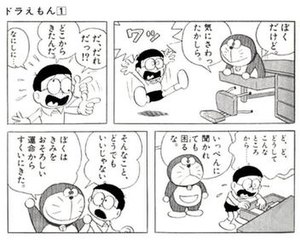Mt. Fuji from Tokyo
Doraemon since 1969
Doraemon is one of the most popular manga (cartoon) titles created in Japan and accepted overseas.
Doraemon is a robot cat that came from the future to save a boy, one of whose future descendants is associated with Doraemon. Doraemon helped the daily life of the boy named Nobita, meaning the knocked-down, with various fantastic and super-high tech goods, since Nobita is a weak boy always suppressed by a big and strong bully and a sly and rich boy, though he has a pretty girl friend. This manga comic story was originally intended for primary school children.
Doraemon was first issued in 1969 when the Vietnam War was still going on and many anti-Vietnam War students were active in Japan, since there were many US military bases in Japan. Japan was marking high growth in economy at the time, partly because of Vietnam War-invoked special procurement boom, with people's lives rapidly changing from a simply highly growing economy after WWII to a country starting to lead the world economy. Japanese youths were also being influenced by hippyism that started in the US in the middle of 1960s, requesting more freedom and equality while denying traditional ethics.
The world of Japanese manga works was also undergoing a big change as baby boomers who had enjoyed juvenile cartoons in their childhood became young adults who wanted more realistic, satirical, and sometimes violent manga works. Many of manga artists changed their styles to match feelings and demands of growing manga readers along with this social trend. But, the author Fujio F. Fujiko never changed his touch. F. Fujiko continued to create and issue juvenile cartoons for readers of every generation.
So, F. Fujiko's Doraemon survived those politically turbulent years, symbolized by the Vietnam War, and psychologically unstable years with social value standards drastically changing due to the coming of affluent society in Japan. In fact, he proved that what is welcomed by children is the same if times are changing.
Fujio F. Fujiko (ne Hiroshi Fujimoto) came to Tokyo from Fukui Prefecture on the Sea of Japan to become a manga artist with his friend Fujio Fujiko (A) (ne Motoo Abiko) in early 1950s when they were 20 years old or so. They respected Osamu Tezuka, the Japanese King of Manga Art. As their works had been praised by Tezuka, they decided to become professional manga artists. Actually, the two young manga artists started to live in a humble room of a humble wooden apartment house Tezuka just moved from. Their drawing touch even resembled Tezuka's.
Even the great manga-world leader Tezuka tried to change his style aimed at children to that more appealing to young adults in 1970s along with the change in the mood of the Japanese society. But F. Fujiko firmly stuck to his old style targeting children. However, his friend Fujiko (A) gradually changed his style to appeal to adult readers. Till Doraemo, F. Fujiko and Fujiko (a) created and issued works together as co-creators, using the common name Fujio Fujiko. But, Doraemon was a work produced only by F. Fujiko.
Fujio F. Fujiko died in 1996, though his best friend and old co-creator Fujiko (A) still lives. Fujiko (A) wrote some books where he admired F. Fujiko who seldom went out for playing golf or drinking with famous actors, actresses, authors, and other celebrities while Fujiko (A) enjoyed such a colorful life in Tokyo as a successful manga artist. F. Fujiko concentrated on his juvenile works for children while always trying to come up with new ideas.
One night in 1969, F. Fujiko was suffering as he had promised to present a new manga work to a magazine company as his old title had been finished. But, F. Fujiko couldn't flash an idea into his mind. Fujiko (A) who had come to Fujiko F.'s house to help him already returned to his office for his work. Alone all through the night F. Fujiko tried to find a theme and a main character of his new manga work in vain. He remembered when he and Fujiko (A) were working hard and living poor in the humble wooden apartment house when they were young. He remembered there was a cat in the apartment house. Finally, the morning came. He felt desperate. Shouting, "I'm finished", F. Fujiko ran down stairs in his house to stomp over a tumble doll of his little daughter. At the moment, he got an idea of a robotic cat that helped a weak boy who was like his old self.

http://en.wikipedia.org/wiki/Doraemon
Today, even Chinese children are enjoying animation films featuring Doraemon. Once when F. Fujiko visited Vietnam, one boy asked him, "Do you have the 4-dimensional pocket Doraemon has?" F. Fujiko answered, "There is one spare suit of clothes with the 4-dimensional pocket in addition to Draemon's. But it is kept secretly. So, I unfortunately have not." Doraemom takes out various dream hi-tech goods from the four-dimensional pocket.
**** **** ****
Mat 5:30 And if thy right hand offend thee, cut it off, and cast it from thee: for it is profitable for thee that one of thy members should perish, and not that thy whole body should be cast into hell.

